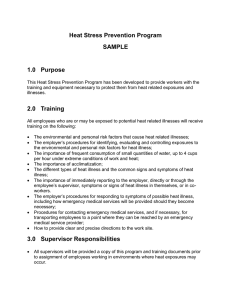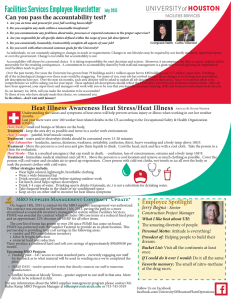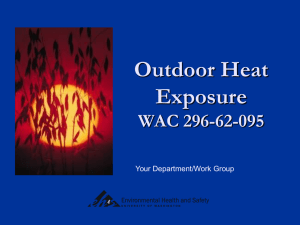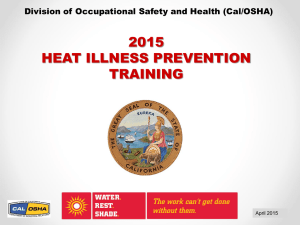Safe Work is Smart Work The Keys to Injury Prevention
advertisement
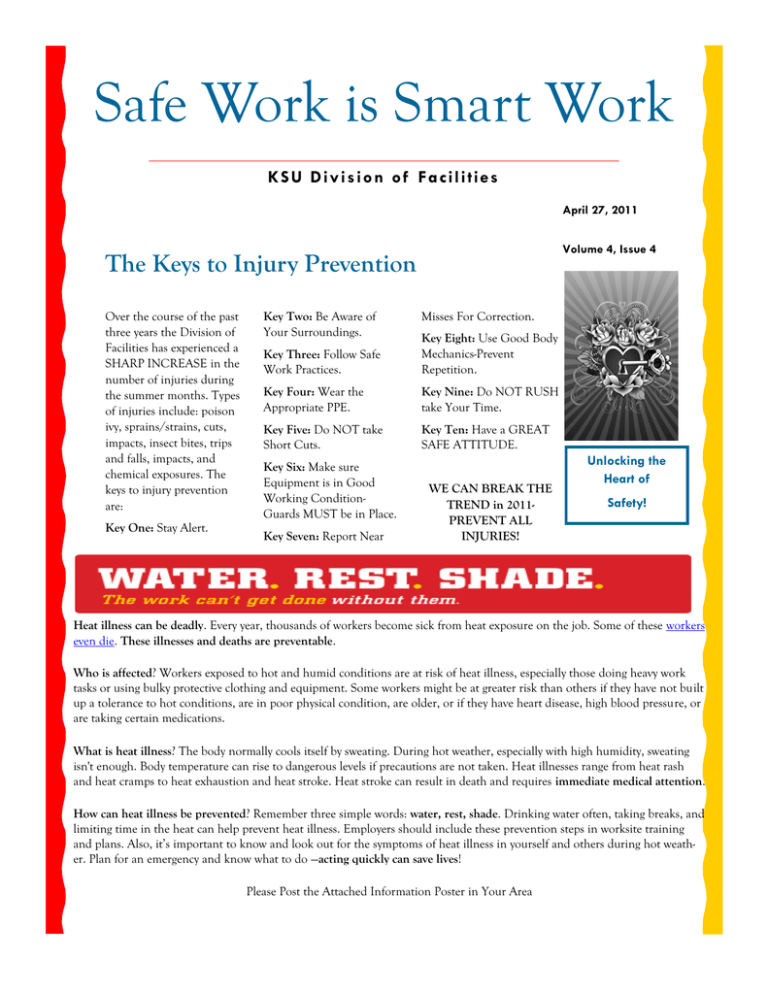
Safe Work is Smart Work KS U D ivis ion of F a cil i tie s April 27, 2011 Volume 4, Issue 4 The Keys to Injury Prevention Over the course of the past three years the Division of Facilities has experienced a SHARP INCREASE in the number of injuries during the summer months. Types of injuries include: poison ivy, sprains/strains, cuts, impacts, insect bites, trips and falls, impacts, and chemical exposures. The keys to injury prevention are: Key One: Stay Alert. Key Two: Be Aware of Your Surroundings. Misses For Correction. Key Three: Follow Safe Work Practices. Key Eight: Use Good Body Mechanics-Prevent Repetition. Key Four: Wear the Appropriate PPE. Key Nine: Do NOT RUSH take Your Time. Key Five: Do NOT take Short Cuts. Key Ten: Have a GREAT SAFE ATTITUDE. Key Six: Make sure Equipment is in Good Working ConditionGuards MUST be in Place. Key Seven: Report Near WE CAN BREAK THE TREND in 2011PREVENT ALL INJURIES! Unlocking the Heart of Safety! Heat illness can be deadly. Every year, thousands of workers become sick from heat exposure on the job. Some of these workers even die. These illnesses and deaths are preventable. Who is affected? Workers exposed to hot and humid conditions are at risk of heat illness, especially those doing heavy work tasks or using bulky protective clothing and equipment. Some workers might be at greater risk than others if they have not built up a tolerance to hot conditions, are in poor physical condition, are older, or if they have heart disease, high blood pressure, or are taking certain medications. What is heat illness? The body normally cools itself by sweating. During hot weather, especially with high humidity, sweating isn't enough. Body temperature can rise to dangerous levels if precautions are not taken. Heat illnesses range from heat rash and heat cramps to heat exhaustion and heat stroke. Heat stroke can result in death and requires immediate medical attention. How can heat illness be prevented? Remember three simple words: water, rest, shade. Drinking water often, taking breaks, and limiting time in the heat can help prevent heat illness. Employers should include these prevention steps in worksite training and plans. Also, it’s important to know and look out for the symptoms of heat illness in yourself and others during hot weather. Plan for an emergency and know what to do —acting quickly can save lives! Please Post the Attached Information Poster in Your Area Health effects of heat Two types of heat illness: Heat Exhaustion Dizziness Headache Cramps Nausea, vomiting Sweaty skin Heat Stroke Weakness Red, hot, dry skin High temperature Confusion Convulsions Fainting Fast heart beat Watch out for early symptoms. You may need medical help. People react differently − you may have just a few of these symptoms, or most of them. 1 Stay safe and healthy! WATER. REST. SHADE. The work can’t get done without them. Drink water even if you aren’t thirsty — every 15 minutes. Rest in the shade. Watch out for each other. Wear hats and light-colored clothing. 2 “Easy does it” on your first days of work in the heat. You need to get used to it. Rest in the shade – at least 5 minutes as needed to cool down. Be prepared for an emergency Heat kills -- get help right away! If someone in your crew has symptoms: 1) Tell the person who has a radio/phone and can call the supervisor – you need medical help. 2) Start providing first aid while you wait for the ambulance to arrive. 3) Move the person to cool off in the shade. 4) Little by little, give him water (as long as he is not vomiting). 5) Loosen his clothing. 6) Help cool him: fan him, put ice packs in groin and underarms, or soak his clothing with cool water. When you call for help, you need to: • Be prepared to describe the symptoms. 3 • Give specific and clear directions to your work site. Heat illness can be prevented! At our work site, we have: Shade to rest and cool down Water We are extra careful when there is a heat wave or temperature goes up. Then we may change our work hours, and we all need more water and rest. Developed by CAL/OSHA 4 For more information: 1-800-321-OSHA (6742) • TTY 1-877-889-5627 • www.osha.gov OSHA 3431-04N 2011 Training and emergency plan


